Raincoat fabric and heaters: what are warm jackets and overalls made of? The outer layer of the jacket, or how to choose the right outer material
Jackets are bought by active people who like to walk and do outdoor sports. From clothing, they expect good protection against cold, rain and wind, as well as the ability to remove moisture from the skin. And modern upper materials have such properties to the full.
For short walks
In the sewing industry, fabrics from natural and synthetic raw materials are used. The first group includes cotton and woolen fabrics. Of course, they cannot boast of being waterproof (this quality appears only when treated with a special compound), but they retain heat and protect from the wind. And they are also characterized by good hygroscopicity.
Yes, clothing made from such fibers is not suitable for staying in the rain and downhill skiing. However, for short walks in good weather it is quite suitable. In addition, such jackets and windbreakers are made not only in sports style, but also in ethno, safari, military and others.
For physical activity
For a long stay fresh air and sports are more suitable products made of synthetic polyester and polyamide. They do not prevent sweat from evaporating, they are windproof, and in the presence of insulation, they perfectly perform the function of thermal insulation.
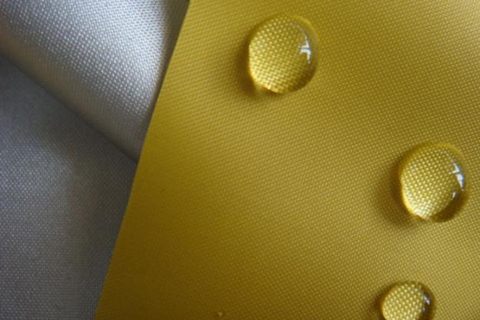
Both materials are characterized by the following properties:
- wrinkle resistance,
- fast drying
- light weight,
- ease of care.
Synthetic fabrics are durable, especially polyamide: it does not rub, does not form creases and does not lose the brightness of colors.

However, for extreme sports like skiing and mountaineering, clothing with enhanced waterproofing and moisture wicking capabilities is required. AND modern science created a special fabric.
Membrane - the "brainchild" of high technology
The thinnest film that can withstand the shower and dry out sweaty skin - it seems that this is something from the realm of fantasy! But such materials have been around for several years. The very first of them - Gore-tex - has become a household name: "in the people" this is what any membrane fabric is called.

This material provides comfort thanks to the multilayer structure. The main component is the membrane itself, which is a film with one-sided permeability. It allows moisture to pass through from the inside and prevents the penetration of water from the outside.
A mandatory component is the outer layer of polyamide or polyester fibers, which has the ability to dry quickly. Being impregnated with a special composition, it also performs a water-repellent function. The liquid that nevertheless passes through it condenses on the film and gradually evaporates. Some manufacturers add an extra layer of absorbent non-woven fabric to improve the waterproofness of the garment.

The body side of the membrane is usually covered protective layer. However, some manufacturers sew on a regular lining instead. Things are not as durable, but they are cheaper.
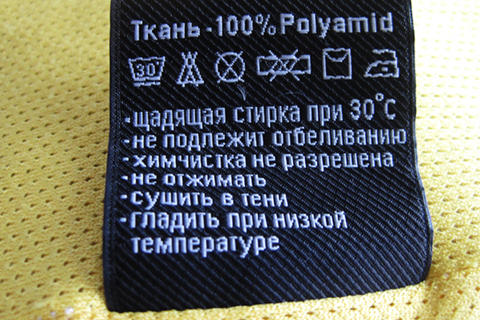
How to understand the indicators on the label
Some consumers are disappointed in this wonderful invention. As a rule, this happens from the inability to choose a demi-season or winter jacket with the right parameters.
Membranes differ in the degree of vapor permeability and water resistance. The first indicator is measured in grams of liquid that 1 sq. m surface per day. For hiking, you need a value of at least 5,000, for skiing - from 10,000, for climbers - 20,000 and above.
Water resistance is measured in millimeters of water column. To withstand light rain, an indicator of 2,000 is enough, but 5,000-8,000 will be optimal for active citizens. Well, in extreme weather conditions, 20,000 mm will save.

In order for the consumer to be satisfied with the purchased jacket, before buying it is necessary to figure out in what situation it will be used. And choose a product from the right material!
Hello my dear readers! I think I won’t be mistaken if I say that many of us, on the eve of winter (and not only), are thinking about the question: how to choose a winter jacket? What should be the top of the jacket? Which filler is best? What is the difference between a membrane and microfiber or polyester? And further in the same spirit.
In today's article, I will teach you how to choose the right winter jacket for a child, woman and man. In principle, this is not difficult if you know the quality of materials, as well as insulation.
If the material is reliable, then in your jacket you can walk in any weather conditions, whether it is sleet or frost. However, it is worth choosing outerwear according to your lifestyle and needs.
How to choose a winter jacket: top material
Depending on what material the top of the jacket will be made of, it will have certain properties:
- Lovers of natural fabrics should know that if the top of the jacket cotton, then the product will get wet, blown by the wind, easily wrinkled and hard to erase. And this is despite the advantages of such material - hypoallergenicity. Also, cotton outerwear is pleasant to the touch and breathable.
- More practical is outerwear with a top made of nylon and polyester. Such materials do not wrinkle, are strong enough, do not get wet during drizzle, are not blown by the wind, are easily washed by hand and in washing machines and dry quickly.
- Your body will breathe in outerwear made of microfiber. The top of such products is wind and moisture resistant. Despite the fact that it is synthetic, this material is very pleasant to the touch and is similar to natural fabrics. However, I note that microfiber is very electrified, and costs a little more than nylon and polyester.
- My favorite upper material, especially for children, is membrane. This is a synthetic material that brings out the fumes coming from the body. It repels moisture well and is also water and wind resistant. However, if you or your child does not move much, then this material will not suit you, since the membrane does not retain heat well when inactive. This outerwear is just perfect for athletes.
- Waterproof fabric able to protect you from strong wind and precipitation. However, such products do not remove moisture from the body and do not allow air to pass through. As a result, a real "greenhouse effect" is formed. And besides, in the process of washing and wearing, the impregnation loses its properties, so it must be treated with special sprays.
What insulation is used in jackets
- Sheep's wool. This is a durable, wear-resistant insulation. Such jackets are sewn with fur down. They can protect you from frost down to -25 degrees and even lower. But they have a couple of disadvantages - they are heavy and quite expensive, and it’s better not to wash them yourself - it’s better to give them to dry cleaning.
- Swan (goose) down and feather is an environmentally friendly natural insulation. In a down jacket, you will feel warm and comfortable even at -30 degrees. However, feathers and down are strong allergens, so people with allergic reactions should avoid such clothes. Down jackets are difficult to care for, they absorb moisture intensively and dry for a very long time.
- Sintepon- this is a soft lightweight insulation, which, unfortunately, will not last long for you, and it will not warm you in severe frost (well, up to a maximum of -15 degrees).
- Holofiber, firetech, isosoft- artificial substitute for down. These are just excellent heaters in every sense, except for the price (it is higher than the synthetic winterizer) - hypoallergenic, warm, do not roll down.
- But the most heat-saving material is considered thinsulate. This is a lightweight, breathable, hypoallergenic, moisture and wear-resistant insulation, but at the same time it is the most expensive.
Watch the video "How to choose a quality down jacket":
So, my dears, we found out what jackets can be found on sale: what the top of the products is made of, what fillers are used. Choose a winter jacket that suits you and your lifestyle.
When choosing a winter jacket for a child, one thing can be said: it should be light, waterproof and windproof, easy to care for (wash, dry). Most accurately meets the needs of little fashionistas membrane clothing. She is not afraid of puddles, mud, snow, ice slides.
How to stay warm in cold weather? The secret is to choose clothes with the right insulation. However, different heaters are designed for different conditions.
The type of jacket you need depends largely on the type of activity you will be doing. Learning some basic concepts about different insulation and waterproof technologies will help you choose the right insulated model.
DOWN OR SYNTHETICS?
There are two main types of insulation used in jackets: down and synthetics. Both types are strong and weaknesses which make them indispensable in certain situations.
fluff |
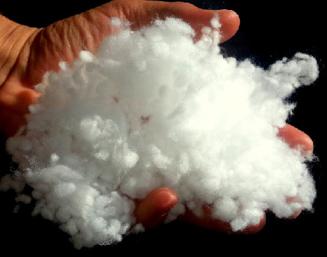 synthetics |
Regardless of their composition, all heaters work on the same basic principle. Your body heat is retained in the air gap (small air pockets) created by the insulation. This layer insulates your body heat from cold weather and keeps you feeling comfortable.
FLUSH
Down is obtained from the plumage of geese and ducks, namely from the fluffy layer under the feathers. Down has a very low weight and effectively retains air. The warmth to weight ratio of down is considered unsurpassed today. In cold and dry weather, down is the warmest and lightest insulation in the world.

Waterproof down
To protect the down from getting wet, it is treated with a hydrophobic (waterproof) coating at the molecular level.
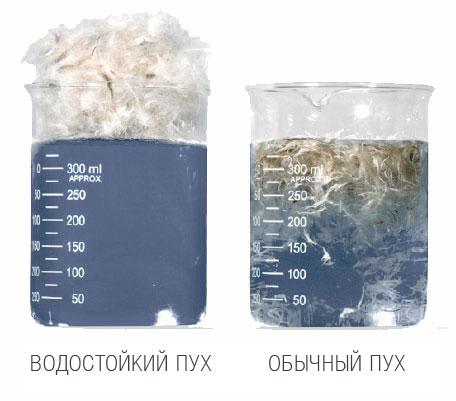
If you love the warmth, lightness, and superior mobility that down insulation provides and you occasionally deal with wet weather, then waterproof down is the way to go.

Each manufacturer has its own names for such down, for example: Marmot Down Defender, DriDown, Q.Shield Down, DownTek, Hydrophobic Down and others.
What is Fill Power?
Fill power- this is the degree of elasticity, that is, the ability of the down to restore its original volume after compression. When looking at down jackets, you will often notice 600 Fill Power, 700 Fill Power, 800 Fill Power and even 900 Fill Power.

How is Fill Power measured?
Down elasticity is measured and internationally certified by an independent laboratory, IDFL, located in the USA. IDFL conducts a test:
- At a certain level of humidity and temperature, 1 ounce of down is taken, which is 28.4 g. The down is placed in a cylinder with transparent walls. The diameter of the test cylinder is 241.3 mm.
- A disk weighing 68.3 g and equal in diameter to the cylinder is lowered onto the down. The fluff is left under the "yoke" for 3-5 days.
- When the disk is removed, the fluff straightens out, tends to take up its maximum volume.
- The final volume of fluff is measured, its density is calculated, which is called the Fill Power indicator. Fill Power is expressed in cubic inches per ounce (in?/oz).
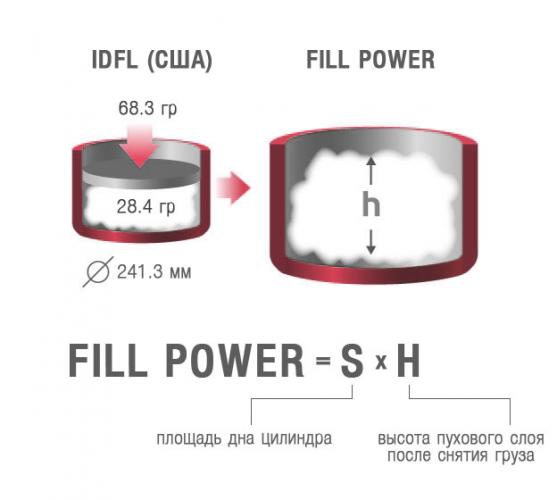
Fill Power is used to evaluate the quality of down. Higher values for the degree of elasticity of the down indicate higher quality, and therefore greater heat capacity and airiness.
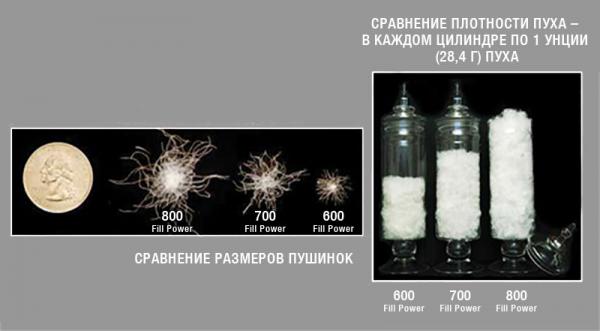
Interestingly, to create the same air layer, that is, the same degree of insulation, 800 Fill Power down is required by 20-25% less than 650 Fill Power down. That is, the more fluffy and heavier down jackets 650 Fill Power warm in the same way as thin, lightweight 800 Fill Power.
Down Benefits
| minimum weight | |
| the world's highest heat capacity, | |
| excellent breathability, | |
| high compression properties, | |
| excellent durability (if the down is of high quality). |
SYNTHETICS
Synthetic insulation is usually made from polyester, which is spun into special fine fibers to mimic the texture of down.

Despite the fact that synthetic insulation is not as warm as down, it still effectively retains warm air. Synthetic insulation is less durable than quality certified down.
Unlike fluff, Synthetic fill keeps you warm even when wet. This advantage makes it an excellent choice for damp or wet conditions.
The benefits of synthetics
| high moisture resistance, | |
| good heat capacity | |
| light weight, | |
| excellent durability, | |
| relatively low price. |
How to stay dry in rainy weather?
How to choose warm clothes we figured it out. Now let's think about how to stay dry and comfortable when it rains or sleet. How to choose a jacket that will protect from any downpour?
Waterproof and breathable membranes
For maximum weather protection, you need a jacket with a waterproof and breathable membrane. A fabric designed using such a membrane is completely impervious to water, but at the same time allows water vapor to escape. Thus, the fabric seems to "breathe" when you start to sweat.

Is the gold standard in the industry for waterproof and breathable technology, but there are now quite a few similar products on the market with at least high level quality (, Pertex® Shield+, others).
DWR processing
Majority outerwear covered DWR (Durable Water Repellent - Durable Water Repellent Treatment). DWR processing is a polymer applied to the right side of the fabric that creates microscopic "pegs" or "spikes". These pegs cause water droplets to curl up and roll off the jacket instead of lingering on the fabric and soaking into it. So when you see water rolling off your jacket, you know it's because of the DWR.
 |
 |
Unlike membranes, which are completely waterproof, there is a limit to the effectiveness of DWR. As a rule of thumb, the DWR can be counted on to keep you dry in light rain or snow. Dirt, grease, smoke, sprays can destroy the pegs formed by the impregnation, thereby reducing the effectiveness of the coating over time. Washing and drying the jacket will restore the DWR, and a series of treatments and special means allows you to independently update the waterproof layer.
Understanding the waterproof rating
Manufacturers of membrane things most often indicate the amount of water resistance, measured in thousands of millimeters of water column. For example, 10,000 mm or 20,000 mm, sometimes there are abbreviations 10K, 15K, 20K and so on. These values are obtained in the so-called "static water column test".

In this test, a 1 inch (2.54 cm) diameter tube is placed vertically on a piece of tissue. Gradually add water to the tube until the fabric begins to leak. This amount of water is then measured in millimeters.
It is believed that fabrics with a rating of 5K or more protect against short rain, 10K or more are waterproof, and those with a rating of 20K or more will not let you get wet even in the worst weather and even with shallow immersions in water.

Choose high-quality things that will justify your hopes, will last a long time and bring only positive emotions.
- Cookies with chocolate chips
- Spring protection of garden plants from pests and diseases
- Salad with daikon "Daffodils" Narcissus salad with crab sticks
- Step by step recipe with photo and video
- Chicken stew with prunes and vegetables in white wine Chicken meat with prunes
- How to cook an ide deliciously: recipes for fried and baked fish
- Chicken borscht in a slow cooker
- Recipes for an incredibly delicious cottage cheese casserole without semolina in the oven: a magnificent and simple dish
- Cooking carp in a slow cooker
- How to cook fish, chicken and turkey steam cutlets for children?
- Coffee cupcakes: recipe with photo Coffee cupcakes in silicone molds
- Tanais - an ancient city at the mouth of the Don River
- Figures of science directions of their activities Concept: Time of appearance
- The relationship of global problems of our time
- Collection of ideal social studies essays
- Cellulose is a polysaccharide
- Testing of weapons samples and their destruction refers to ______ hazard factors. The figure shows the location of two fixed positive
- If we increase the mass of the pendulum, how will the
- Test in social studies, section "Economics
- Send by email









